MXene Surface Architectonics: Bridging Molecular Design to Multifunctional Applications
Abstract
1. Introduction
2. Approaches for MXenes’ Surface Modification
2.1. Synthesis Routes of MXene
2.2. Surface Modification of MXene
3. Applications
3.1. Energy Storage and Conversion
3.2. Reinforcing Material Strength
3.3. Electronics
3.4. Biomedicine
3.5. Environmental Protection
3.6. Others
4. Challenges and Perspectives
4.1. Challenges
4.2. Perspectives
Funding
Data Availability Statement
Acknowledgments
Conflicts of Interest
References
- VahidMohammadi, A.; Rosen, J.; Gogotsi, Y. The world of two-dimensional carbides and nitrides (MXenes). Science 2021, 372, eabf1581. [Google Scholar] [CrossRef] [PubMed]
- Michałowski, P.P.; Anayee, M.; Mathis, T.S.; Kozdra, S.; Wójcik, A.; Hantanasirisakul, K.; Jóźwik, I.; Piątkowska, A.; Możdżonek, M.; Malinowska, A. Oxycarbide MXenes and MAX phases identification using monoatomic layer-by-layer analysis with ultralow-energy secondary-ion mass spectrometry. Nat. Nanotechnol. 2022, 17, 1192–1197. [Google Scholar] [CrossRef] [PubMed]
- Zhang, B.; Wong, P.W.; Guo, J.; Zhou, Y.; Wang, Y.; Sun, J.; Jiang, M.; Wang, Z.; An, A.K. Transforming Ti3C2Tx MXene’s intrinsic hydrophilicity into superhydrophobicity for efficient photothermal membrane desalination. Nat. Commun. 2022, 13, 3315. [Google Scholar] [CrossRef] [PubMed]
- Lai, W.; Zhao, S.; Guo, M.; Wu, D.; Luo, S.; Zhang, C.; Huang, T.; He, W.; Li, M.; Zhou, X. Nitrogen Doping Engineering of V2CTx based Zinc Ion Hybrid Microcapacitors with Quadruple High Energy Density. Chem. Eng. J. 2024, 499, 156668. [Google Scholar] [CrossRef]
- Guo, Y.; Jin, S.; Wang, L.; He, P.; Hu, Q.; Fan, L.-Z.; Zhou, A. Synthesis of two-dimensional carbide Mo2CTx MXene by hydrothermal etching with fluorides and its thermal stability. Ceram. Int. 2020, 46, 19550–19556. [Google Scholar] [CrossRef]
- Lyu, S.; Chang, H.; Zhang, L.; Wang, S.; Li, S.; Lu, Y.; Li, S. High specific surface area MXene/SWCNT/cellulose nanofiber aerogel film as an electrode for flexible supercapacitors. Compos. Part B 2023, 264, 110888. [Google Scholar] [CrossRef]
- Xue, Y.; Feng, J.; Huo, S.; Song, P.; Yu, B.; Liu, L.; Wang, H. Polyphosphoramide-intercalated MXene for simultaneously enhancing thermal stability, flame retardancy and mechanical properties of polylactide. Chem. Eng. J. 2020, 397, 125336. [Google Scholar] [CrossRef]
- Jiang, M.; Wang, D.; Kim, Y.H.; Duan, C.; Talapin, D.V.; Zhou, C. Evolution of Surface Chemistry in Two-Dimensional MXenes: From Mixed to Tunable Uniform Terminations. Angew. Chem. 2024, 136, e202409480. [Google Scholar] [CrossRef]
- Jia, L.; Zhou, S.; Ahmed, A.; Yang, Z.; Liu, S.; Wang, H.; Li, F.; Zhang, M.; Zhang, Y.; Sun, L. Tuning MXene electrical conductivity towards multifunctionality. Chem. Eng. J. 2023, 475, 146361. [Google Scholar] [CrossRef]
- Naguib, M.; Barsoum, M.W.; Gogotsi, Y. Ten years of progress in the synthesis and development of MXenes. Adv. Mater. 2021, 33, 2103393. [Google Scholar] [CrossRef]
- Li, K.; Liang, M.; Wang, H.; Wang, X.; Huang, Y.; Coelho, J.; Pinilla, S.; Zhang, Y.; Qi, F.; Nicolosi, V. 3D MXene architectures for efficient energy storage and conversion. Adv. Funct. Mater. 2020, 30, 2000842. [Google Scholar] [CrossRef]
- Ihsanullah, I. Potential of MXenes in water desalination: Current status and perspectives. Nano-Micro Lett. 2020, 12, 72. [Google Scholar] [CrossRef] [PubMed]
- Lipton, J.; Röhr, J.A.; Dang, V.; Goad, A.; Maleski, K.; Lavini, F.; Han, M.; Tsai, E.H.; Weng, G.-M.; Kong, J. Scalable, highly conductive, and micropatternable MXene films for enhanced electromagnetic interference shielding. Matter 2020, 3, 546–557. [Google Scholar] [CrossRef]
- Soleymaniha, M.; Shahbazi, M.A.; Rafieerad, A.R.; Maleki, A.; Amiri, A. Promoting role of MXene nanosheets in biomedical sciences: Therapeutic and biosensing innovations. Adv. Healthc. Mater. 2019, 8, 1801137. [Google Scholar] [CrossRef]
- Saha, A.; Shpigel, N.; Rosy; Leifer, N.; Taragin, S.; Sharabani, T.; Aviv, H.; Perelshtein, I.; Nessim, G.D.; Noked, M. Enhancing the energy storage capabilities of Ti3C2Tx MXene electrodes by atomic surface reduction. Adv. Funct. Mater. 2021, 31, 2106294. [Google Scholar] [CrossRef]
- Xie, Y.; Dall’Agnese, Y.; Naguib, M.; Gogotsi, Y.; Barsoum, M.W.; Zhuang, H.L.; Kent, P.R. Prediction and characterization of MXene nanosheet anodes for non-lithium-ion batteries. ACS Nano 2014, 8, 9606–9615. [Google Scholar] [CrossRef]
- Tang, Q.; Zhou, Z.; Shen, P. Are MXenes promising anode materials for Li ion batteries? Computational studies on electronic properties and Li storage capability of Ti3C2 and Ti3C2X2 (X = F, OH) monolayer. J. Am. Chem. Soc. 2012, 134, 16909–16916. [Google Scholar] [CrossRef]
- Ling, C.; Shi, L.; Ouyang, Y.; Chen, Q.; Wang, J. Transition metal-promoted V2CO2 (MXenes): A new and highly active catalyst for hydrogen evolution reaction. Adv. Sci. 2016, 3, 1600180. [Google Scholar] [CrossRef]
- Meng, Q.; Ma, J.; Zhang, Y.; Li, Z.; Zhi, C.; Hu, A.; Fan, J. The S-functionalized Ti3C2 Mxene as a high capacity electrode material for Na-ion batteries: A DFT study. Nanoscale 2018, 10, 3385–3392. [Google Scholar] [CrossRef]
- Kajiyama, S.; Szabova, L.; Iinuma, H.; Sugahara, A.; Gotoh, K.; Sodeyama, K.; Tateyama, Y.; Okubo, M.; Yamada, A. Enhanced Li-ion accessibility in MXene titanium carbide by steric chloride termination. Adv. Energy Mater. 2017, 7, 1601873. [Google Scholar] [CrossRef]
- Zhu, J.; Schwingenschlögl, U. P and Si functionalized MXenes for metal-ion battery applications. 2D Mater. 2017, 4, 025073. [Google Scholar] [CrossRef]
- Mashtalir, O.; Naguib, M.; Mochalin, V.N.; Dall’Agnese, Y.; Heon, M.; Barsoum, M.W.; Gogotsi, Y. Intercalation and Delamination of Layered Carbides and Carbonitrides. In MXenes; Jenny Stanford Publishing: Singapore, 2023; pp. 359–377. [Google Scholar]
- Xie, Y.; Naguib, M.; Mochalin, V.N.; Barsoum, M.W.; Gogotsi, Y.; Yu, X.; Nam, K.-W.; Yang, X.-Q.; Kolesnikov, A.I.; Kent, P.R. Role of surface structure on Li-ion energy storage capacity of two-dimensional transition-metal carbides. J. Am. Chem. Soc. 2014, 136, 6385–6394. [Google Scholar] [CrossRef] [PubMed]
- Hu, M.; Hu, T.; Li, Z.; Yang, Y.; Cheng, R.; Yang, J.; Cui, C.; Wang, X. Surface functional groups and interlayer water determine the electrochemical capacitance of Ti3C2Tx MXene. ACS Nano 2018, 12, 3578–3586. [Google Scholar] [CrossRef]
- Hu, M.; Li, Z.; Hu, T.; Zhu, S.; Zhang, C.; Wang, X. High-capacitance mechanism for Ti3C2Tx MXene by in situ electrochemical Raman spectroscopy investigation. ACS Nano 2016, 10, 11344–11350. [Google Scholar] [CrossRef] [PubMed]
- Wyatt, B.C.; Rosenkranz, A.; Anasori, B. 2D MXenes: Tunable mechanical and tribological properties. Adv. Mater. 2021, 33, 2007973. [Google Scholar] [CrossRef]
- Zhao, G.; Li, X.; Huang, M.; Zhen, Z.; Zhong, Y.; Chen, Q.; Zhao, X.; He, Y.; Hu, R.; Yang, T. The physics and chemistry of graphene-on-surfaces. Chem. Soc. Rev. 2017, 46, 4417–4449. [Google Scholar] [CrossRef]
- Lv, R.; Robinson, J.A.; Schaak, R.E.; Sun, D.; Sun, Y.; Mallouk, T.E.; Terrones, M. Transition metal dichalcogenides and beyond: Synthesis, properties, and applications of single-and few-layer nanosheets. Acc. Chem. Res. 2015, 48, 56–64. [Google Scholar] [CrossRef]
- Thurakkal, S.; Zhang, X. Recent advances in chemical functionalization of 2D black phosphorous nanosheets. Adv. Sci. 2020, 7, 1902359. [Google Scholar] [CrossRef]
- Dahlqvist, M.; Rosen, J. Chalcogen and halogen surface termination coverage in MXenes—Structure, stability, and properties. npj 2D Mater. Appl. 2024, 8, 65. [Google Scholar] [CrossRef]
- Feng, A.; Yu, Y.; Jiang, F.; Wang, Y.; Mi, L.; Yu, Y.; Song, L. Fabrication and thermal stability of NH4HF2-etched Ti3C2 MXene. Ceram. Int. 2017, 43, 6322–6328. [Google Scholar] [CrossRef]
- Feng, A.; Yu, Y.; Wang, Y.; Jiang, F.; Yu, Y.; Mi, L.; Song, L. Two-dimensional MXene Ti3C2 produced by exfoliation of Ti3AlC2. Mater. Des. 2017, 114, 161–166. [Google Scholar] [CrossRef]
- Kamysbayev, V.; Filatov, A.S.; Hu, H.; Rui, X.; Lagunas, F.; Wang, D.; Klie, R.F.; Talapin, D.V. Covalent surface modifications and superconductivity of two-dimensional metal carbide MXenes. Science 2020, 369, 979–983. [Google Scholar] [CrossRef] [PubMed]
- Li, Y.; Shao, H.; Lin, Z.; Lu, J.; Liu, L.; Duployer, B.; Persson, P.O.; Eklund, P.; Hultman, L.; Li, M. A general Lewis acidic etching route for preparing MXenes with enhanced electrochemical performance in non-aqueous electrolyte. Nat. Mater. 2020, 19, 894–899. [Google Scholar] [CrossRef]
- Li, M.; Lu, J.; Luo, K.; Li, Y.; Chang, K.; Chen, K.; Zhou, J.; Rosen, J.; Hultman, L.; Eklund, P. Element replacement approach by reaction with Lewis acidic molten salts to synthesize nanolaminated MAX phases and MXenes. J. Am. Chem. Soc. 2019, 141, 4730–4737. [Google Scholar] [CrossRef] [PubMed]
- Li, M.; Li, X.; Qin, G.; Luo, K.; Lu, J.; Li, Y.; Liang, G.; Huang, Z.; Zhou, J.; Hultman, L. Halogenated Ti3C2 MXenes with electrochemically active terminals for high-performance zinc ion batteries. ACS Nano 2021, 15, 1077–1085. [Google Scholar] [CrossRef]
- Zhang, T.; Shao, W.; Liu, S.; Song, Z.; Mao, R.; Jin, X.; Jian, X.; Hu, F. A flexible design strategy to modify Ti3C2Tx MXene surface terminations via nucleophilic substitution for long-life Li-S batteries. J. Energy Chem. 2022, 74, 349–358. [Google Scholar] [CrossRef]
- Usman, K.A.S.; Judicpa, M.; Bacal, C.J.O.; Marquez, K.P.; Zhang, J.; Dharmasiri, B.; Randall, J.D.; Henderson, L.C.; Razal, J.M. A one-pot strategy for modifying the surface of Ti3C2Tx MXene. Surf. Coat. Technol. 2024, 494, 131522. [Google Scholar] [CrossRef]
- Riazi, H.; Anayee, M.; Hantanasirisakul, K.; Shamsabadi, A.A.; Anasori, B.; Gogotsi, Y.; Soroush, M. Surface modification of a MXene by an aminosilane coupling agent. Adv. Mater. Interfaces 2020, 7, 1902008. [Google Scholar] [CrossRef]
- Li, X.; Huang, Z.; Shuck, C.E.; Liang, G.; Gogotsi, Y.; Zhi, C. MXene chemistry, electrochemistry and energy storage applications. Nat. Rev. Chem. 2022, 6, 389–404. [Google Scholar] [CrossRef]
- Fu, Z.; Wang, N.; Legut, D.; Si, C.; Zhang, Q.; Du, S.; Germann, T.C.; Francisco, J.S.; Zhang, R. Rational design of flexible two-dimensional MXenes with multiple functionalities. Chem. Rev. 2019, 119, 11980–12031. [Google Scholar] [CrossRef]
- Zou, J.; Wu, J.; Wang, Y.; Deng, F.; Jiang, J.; Zhang, Y.; Liu, S.; Li, N.; Zhang, H.; Yu, J. Additive-mediated intercalation and surface modification of MXenes. Chem. Soc. Rev. 2022, 51, 2972–2990. [Google Scholar] [CrossRef] [PubMed]
- El-Demellawi, J.K.; Lopatin, S.; Yin, J.; Mohammed, O.F.; Alshareef, H.N. Tunable multipolar surface plasmons in 2D Ti3C2Tx MXene flakes. ACS Nano 2018, 12, 8485–8493. [Google Scholar] [CrossRef]
- Xue, Q.; Zhang, H.; Zhu, M.; Pei, Z.; Li, H.; Wang, Z.; Huang, Y.; Huang, Y.; Deng, Q.; Zhou, J. Photoluminescent Ti3C2 MXene quantum dots for multicolor cellular imaging. Adv. Mater. 2017, 29, 1604847. [Google Scholar] [CrossRef] [PubMed]
- Lu, S.; Sui, L.; Liu, Y.; Yong, X.; Xiao, G.; Yuan, K.; Liu, Z.; Liu, B.; Zou, B.; Yang, B. White photoluminescent Ti3C2 MXene quantum dots with two-photon fluorescence. Adv. Sci. 2019, 6, 1801470. [Google Scholar] [CrossRef]
- Bai, Y.; Zhou, K.; Srikanth, N.; Pang, J.H.; He, X.; Wang, R. Dependence of elastic and optical properties on surface terminated groups in two-dimensional MXene monolayers: A first-principles study. RSC Adv. 2016, 6, 35731–35739. [Google Scholar] [CrossRef]
- Berdiyorov, G.R. Optical properties of functionalized Ti3C2T2 (T = F, O, OH) MXene: First-principles calculations. Aip Adv. 2016, 6, 055105. [Google Scholar] [CrossRef]
- Kim, H.; Alshareef, H.N. MXetronics: MXene-enabled electronic and photonic devices. ACS Mater. Lett. 2019, 2, 55–70. [Google Scholar] [CrossRef]
- Kim, Y.-J.; Kim, S.J.; Seo, D.; Chae, Y.; Anayee, M.; Lee, Y.; Gogotsi, Y.; Ahn, C.W.; Jung, H.-T. Etching mechanism of monoatomic aluminum layers during MXene synthesis. Chem. Mater. 2021, 33, 6346–6355. [Google Scholar] [CrossRef]
- Liu, F.; Zhou, A.; Chen, J.; Jia, J.; Zhou, W.; Wang, L.; Hu, Q. Preparation of Ti3C2 and Ti2C MXenes by fluoride salts etching and methane adsorptive properties. Appl. Surf. Sci. 2017, 416, 781–789. [Google Scholar] [CrossRef]
- Kumar, S. Fluorine-Free MXenes: Recent Advances, Synthesis Strategies, and Mechanisms. Small 2024, 20, 2308225. [Google Scholar] [CrossRef]
- Gao, Z.; Lai, W. Structural-modulated substrate of MXene for surface-enhanced Raman scattering sensing. ChemPhysChem 2025, 26, e202400604. [Google Scholar] [CrossRef] [PubMed]
- Xiong, Y.; Zhang, Y.; Wang, Y.; Ma, N.; Zhao, J.; Luo, S.; Fan, J. A DFT study on regulating the active center of v-Ti2XT2 MXene through surface modification for efficient nitrogen fixation. J. Colloid Interface Sci. 2024, 664, 1–12. [Google Scholar] [CrossRef]
- Faraji, M.; Bafekry, A.; Fadlallah, M.; Molaei, F.; Hieu, N.; Qian, P.; Ghergherehchi, M.; Gogova, D. Surface modification of titanium carbide MXene monolayers (Ti2C and Ti3C2) via chalcogenide and halogenide atoms. Phys. Chem. Chem. Phys. 2021, 23, 15319–15328. [Google Scholar] [CrossRef]
- Je, S.H.; Kim, H.J.; Kim, J.; Choi, J.W.; Coskun, A. Perfluoroaryl-elemental sulfur SNAr chemistry in covalent triazine frameworks with high sulfur contents for lithium–sulfur batteries. Adv. Funct. Mater. 2017, 27, 1703947. [Google Scholar] [CrossRef]
- Chen, X.; Zhu, Y.; Zhang, M.; Sui, J.; Peng, W.; Li, Y.; Zhang, G.; Zhang, F.; Fan, X. N-butyllithium-treated Ti3C2Tx MXene with excellent pseudocapacitor performance. ACS Nano 2019, 13, 9449–9456. [Google Scholar] [CrossRef] [PubMed]
- Dall’Agnese, Y.; Lukatskaya, M.R.; Cook, K.M.; Taberna, P.-L.; Gogotsi, Y.; Simon, P. High capacitance of surface-modified 2D titanium carbide in acidic electrolyte. Electrochem. Commun. 2014, 48, 118–122. [Google Scholar] [CrossRef]
- Li, J.; Yuan, X.; Lin, C.; Yang, Y.; Xu, L.; Du, X.; Xie, J.; Lin, J.; Sun, J. Achieving high pseudocapacitance of 2D titanium carbide (MXene) by cation intercalation and surface modification. Adv. Energy Mater. 2017, 7, 1602725. [Google Scholar] [CrossRef]
- Cao, M.; Wang, F.; Wang, L.; Wu, W.; Lv, W.; Zhu, J. Room temperature oxidation of Ti3C2 MXene for supercapacitor electrodes. J. Electrochem. Soc. 2017, 164, A3933. [Google Scholar] [CrossRef]
- Heckler, J.E.; Neher, G.R.; Mehmood, F.; Lioi, D.B.; Pachter, R.; Vaia, R.; Kennedy, W.J.; Nepal, D. Surface functionalization of Ti3C2Tx MXene nanosheets with catechols: Implication for colloidal processing. Langmuir 2021, 37, 5447–5456. [Google Scholar] [CrossRef]
- Kumar, S.; Lei, Y.; Alshareef, N.H.; Quevedo-Lopez, M.; Salama, K.N. Biofunctionalized two-dimensional Ti3C2 MXenes for ultrasensitive detection of cancer biomarker. Biosens. Bioelectron. 2018, 121, 243–249. [Google Scholar] [CrossRef]
- McDaniel, R.M.; Carey, M.S.; Wilson, O.R.; Barsoum, M.W.; Magenau, A.J. Well-dispersed nanocomposites using covalently modified, multilayer, 2D titanium carbide (MXene) and in-situ “Click” polymerization. Chem. Mater. 2021, 33, 1648–1656. [Google Scholar] [CrossRef]
- Kim, D.; Ko, T.Y.; Kim, H.; Lee, G.H.; Cho, S.; Koo, C.M. Nonpolar organic dispersion of 2D Ti3C2Tx MXene flakes via simultaneous interfacial chemical grafting and phase transfer method. ACS Nano 2019, 13, 13818–13828. [Google Scholar] [CrossRef]
- Jing, H.; Yeo, H.; Lyu, B.; Ryou, J.; Choi, S.; Park, J.-H.; Lee, B.H.; Kim, Y.-H.; Lee, S. Modulation of the electronic properties of MXene (Ti3C2Tx) via surface-covalent functionalization with diazonium. ACS Nano 2021, 15, 1388–1396. [Google Scholar] [CrossRef] [PubMed]
- Chen, C.; Boota, M.; Urbankowski, P.; Anasori, B.; Miao, L.; Jiang, J.; Gogotsi, Y. Effect of glycine functionalization of 2D titanium carbide (MXene) on charge storage. J. Mater. Chem. A 2018, 6, 4617–4622. [Google Scholar] [CrossRef]
- Boota, M.; Chen, C.; Yang, L.; Kolesnikov, A.I.; Osti, N.C.; Porzio, W.; Barba, L.; Jiang, J. Probing molecular interactions at MXene–organic heterointerfaces. Chem. Mater. 2020, 32, 7884–7894. [Google Scholar] [CrossRef]
- Giordano, A.N.; Jiang, J.; Advincula, A.; Shevchuk, K.; Carey, M.S.; Back, T.C.; Gogotsi, Y.; Nepal, D.; Pachter, R.; Rao, R. Raman Spectroscopy and Laser-Induced Surface Modification of Nb2CTx MXene. ACS Mater. Lett. 2024, 6, 3264–3271. [Google Scholar] [CrossRef]
- Jiang, J.; Wen, D.; Zhao, W.; Zhao, L. Radiation-Induced Surface Modification of MXene with Ionic Liquid to Improve Electrochemical Properties and Chemical Stability. Langmuir 2023, 39, 13890–13896. [Google Scholar] [CrossRef] [PubMed]
- Qi, K.; Zhang, F. Rational surface engineering of Ti3C2Tx MXene for high-performance lithium-sulfur batteries. Mater. Lett. 2022, 318, 132134. [Google Scholar] [CrossRef]
- Xu, J.; Longchamps, R.S.; Wang, X.; Hu, B.; Li, X.; Wang, S.; Li, L.; Gu, Y.; Cao, X.; Yuan, N. Nucleophilic Substitution Enables MXene Maximum Capacitance and Improved Stability. Adv. Funct. Mater. 2024, 34, 2408892. [Google Scholar] [CrossRef]
- Liu, L.; Zschiesche, H.; Antonietti, M.; Daffos, B.; Tarakina, N.V.; Gibilaro, M.; Chamelot, P.; Massot, L.; Duployer, B.; Taberna, P.L.; et al. Tuning the surface chemistry of MXene to improve energy storage: Example of nitrification by salt melt. Adv. Energy Mater. 2023, 13, 2202709. [Google Scholar] [CrossRef]
- Tian, Y.; Que, B.; Luo, Y.; Ju, M.; Tang, Y.; Lou, X.; Chen, Z.; Que, W. Amino-rich surface-modified MXene as anode for hybrid aqueous proton supercapacitors with superior volumetric capacity. J. Power Sources 2021, 495, 229790. [Google Scholar] [CrossRef]
- Li, L.; Niu, H.; Robertson, J.; Jiang, Z.; Guo, Y.; Kuai, C. Cyclocrosslinked polyphosphazene modified MXene as aqueous supercapacitor. Electrochim. Acta 2023, 439, 141574. [Google Scholar] [CrossRef]
- Udhayakumar, H.H.; Park, Y.H.; Park, E.; Murali, G.; Park, S.; Kim, J.; Yeon, J.; Lee, S.J.; Kim, S.; Yang, H. Highly oxidation resistant and organic dispersible ligand functionalized MXene for triggering performance of lithium ion batteries. Chem. Eng. J. 2024, 488, 150699. [Google Scholar] [CrossRef]
- Gao, J.; Du, C.-F.; Zhang, T.; Zhang, X.; Ye, Q.; Liu, S.; Liu, W. Dialkyl Dithiophosphate-Functionalized Ti3C2Tx MXene Nanosheets as Effective Lubricant Additives for Antiwear and Friction Reduction. ACS Appl. Nano Mater. 2021, 4, 11080–11087. [Google Scholar] [CrossRef]
- Guo, J.; Zeng, C.; Wu, P.; Liu, G.; Zhou, F.; Liu, W. Surface-functionalized Ti3C2Tx MXene as a kind of efficient lubricating additive for supramolecular gel. ACS Appl. Mater. Interfaces 2022, 14, 52566–52573. [Google Scholar] [CrossRef]
- Qu, C.; Li, S.; Zhang, Y.; Wang, T.; Wang, Q.; Chen, S. Surface modification of Ti3C2-MXene with polydopamine and amino silane for high performance nitrile butadiene rubber composites. Tribol. Int. 2021, 163, 107150. [Google Scholar] [CrossRef]
- Mullani, N.B.; Kumbhar, D.D.; Lee, D.H.; Kwon, M.J.; Cho, S.Y.; Oh, N.; Kim, E.T.; Dongale, T.D.; Nam, S.Y.; Park, J.H. Surface Modification of a Titanium Carbide MXene Memristor to Enhance Memory Window and Low-Power Operation. Adv. Funct. Mater. 2023, 33, 2300343. [Google Scholar] [CrossRef]
- Sun, W.-J.; Zhao, Y.-Y.; Cheng, X.-F.; He, J.-H.; Lu, J.-M. Surface Functionalization of Single-Layered Ti3C2Tx MXene and Its Application in Multilevel Resistive Memory. ACS Appl. Mater. Interfaces 2020, 12, 9865–9871. [Google Scholar] [CrossRef]
- Liu, A.; Liu, Y.; Liu, G.; Zhang, A.; Cheng, Y.; Li, Y.; Zhang, L.; Wang, L.; Zhou, H.; Liu, J. Engineering of surface modified Ti3C2Tx MXene based dually controlled drug release system for synergistic multitherapies of cancer. Chem. Eng. J. 2022, 448, 137691. [Google Scholar] [CrossRef]
- Korupalli, C.; You, K.-L.; Getachew, G.; Rasal, A.S.; Dirersa, W.B.; Zakki Fahmi, M.; Chang, J.-Y. Engineering the surface of Ti3C2 MXene nanosheets for high stability and multimodal anticancer therapy. Pharmaceutics 2022, 14, 304. [Google Scholar] [CrossRef]
- Mu, W.; Du, S.; Yu, Q.; Li, X.; Wei, H.; Yang, Y. Improving barium ion adsorption on two-dimensional titanium carbide by surface modification. Dalton Trans. 2018, 47, 8375–8381. [Google Scholar] [CrossRef] [PubMed]
- Ashebo, M.M.; Liu, N.; Yu, F.; Ma, J. Surface functional modification of Nb2CTx MXene for high performance capacitive deionization. Sep. Purif. Technol. 2024, 343, 127125. [Google Scholar] [CrossRef]
- Wu, Z.-H.; Feng, X.-L.; Qu, Y.-X.; Gong, L.-X.; Cao, K.; Zhang, G.-D.; Shi, Y.; Gao, J.-F.; Song, P.; Tang, L.-C. Silane modified MXene/polybenzazole nanocomposite aerogels with exceptional surface hydrophobicity, flame retardance and thermal insulation. Compos. Commun. 2023, 37, 101402. [Google Scholar] [CrossRef]
- Wang, X.; Zhang, R.; Ma, C.; Yan, W.; Wei, Y.; Tian, J.; Ma, M.; Li, Q.; Shao, M. Surface hydrophobic modification of MXene to promote the electrochemical conversion of N2 to NH3. J. Energy Chem. 2023, 87, 439–449. [Google Scholar] [CrossRef]
- Halim, J.; Kota, S.; Lukatskaya, M.R.; Naguib, M.; Zhao, M.Q.; Moon, E.J.; Pitock, J.; Nanda, J.; May, S.J.; Gogotsi, Y. Synthesis and characterization of 2D molybdenum carbide (MXene). Adv. Funct. Mater. 2016, 26, 3118–3127. [Google Scholar] [CrossRef]
- Fan, J.; Wang, C.; Wang, B.; Wang, B.; Liu, F. Highly Sensitive and Stable Multifunctional Self-Powered Triboelectric Sensor Utilizing Mo2CTx/PDMS Composite Film for Pressure Sensing and Non-Contact Sensing. Nanomaterials 2024, 14, 428. [Google Scholar] [CrossRef]
- Li, Z.; Zhang, B.; Fu, C.; Tao, R.; Li, H.; Luo, J. Ultrafast and sensitive hydrophobic QCM humidity sensor by sulfur modified Ti3C2Tx MXene. IEEE Sens. J. 2022, 23, 3462–3468. [Google Scholar] [CrossRef]
- Qiao, C.; Wu, H.; Xu, X.; Guan, Z.; Ou-Yang, W. Electrical conductivity enhancement and electronic applications of 2D Ti3C2Tx MXene materials. Adv. Mater. Interfaces 2021, 8, 2100903. [Google Scholar] [CrossRef]
- Rajavel, K.; Yu, X.; Zhu, P.; Hu, Y.; Sun, R.; Wong, C. Investigation on the structural quality dependent electromagnetic interference shielding performance of few-layer and lamellar Nb2CTx MXene nanostructures. J. Alloys Compd. 2021, 877, 160235. [Google Scholar] [CrossRef]
- He, Y.; Sun, H.; Wang, Y.; Mu, C.; Chen, L. Nb2CTx MXene coating with inhibition of oxidative stress prepared by Marangoni effect for hemodialysis therapy. Chem. Eng. J. 2024, 485, 150047. [Google Scholar] [CrossRef]
- Li, X.; Yin, X.; Liang, S.; Li, M.; Cheng, L.; Zhang, L. 2D carbide MXene Ti2CTX as a novel high-performance electromagnetic interference shielding material. Carbon 2019, 146, 210–217. [Google Scholar] [CrossRef]
- Liu, G.; Shen, J.; Ji, Y.; Liu, Q.; Liu, G.; Yang, J.; Jin, W. Two-dimensional Ti2CTx MXene membranes with integrated and ordered nanochannels for efficient solvent dehydration. J. Mater. Chem. A 2019, 7, 12095–12104. [Google Scholar] [CrossRef]
- Ying, G.; Kota, S.; Dillon, A.D.; Fafarman, A.T.; Barsoum, M.W. Conductive transparent V2CTx (MXene) films. FlatChem 2018, 8, 25–30. [Google Scholar] [CrossRef]
- Chen, C.; Wang, T.; Zhao, X.; Wu, A.; Li, S.; Zhang, N.; Qu, X.; Jiao, L.; Liu, Y. Customizing Hydrophilic Terminations for V2CTx MXene Toward Superior Hybrid-Ion Storage in Aqueous Zinc Batteries. Adv. Funct. Mater. 2024, 34, 2308508. [Google Scholar] [CrossRef]
- Zhang, W.; Li, S.; Fan, X.; Zhang, X.; Fan, S.; Bei, G. Two-dimensional carbonitride MXenes: From synthesis to properties and applications. Carbon Energy 2024, 6, e609. [Google Scholar] [CrossRef]
- Zhang, B.; Ju, Z.; Xie, Q.; Luo, J.; Du, L.; Zhang, C.J.; Tao, X. Ti3CNTx MXene/rGO scaffolds directing the formation of a robust, layered SEI toward high-rate and long-cycle lithium metal batteries. Energy Storage Mater. 2023, 58, 322–331. [Google Scholar] [CrossRef]

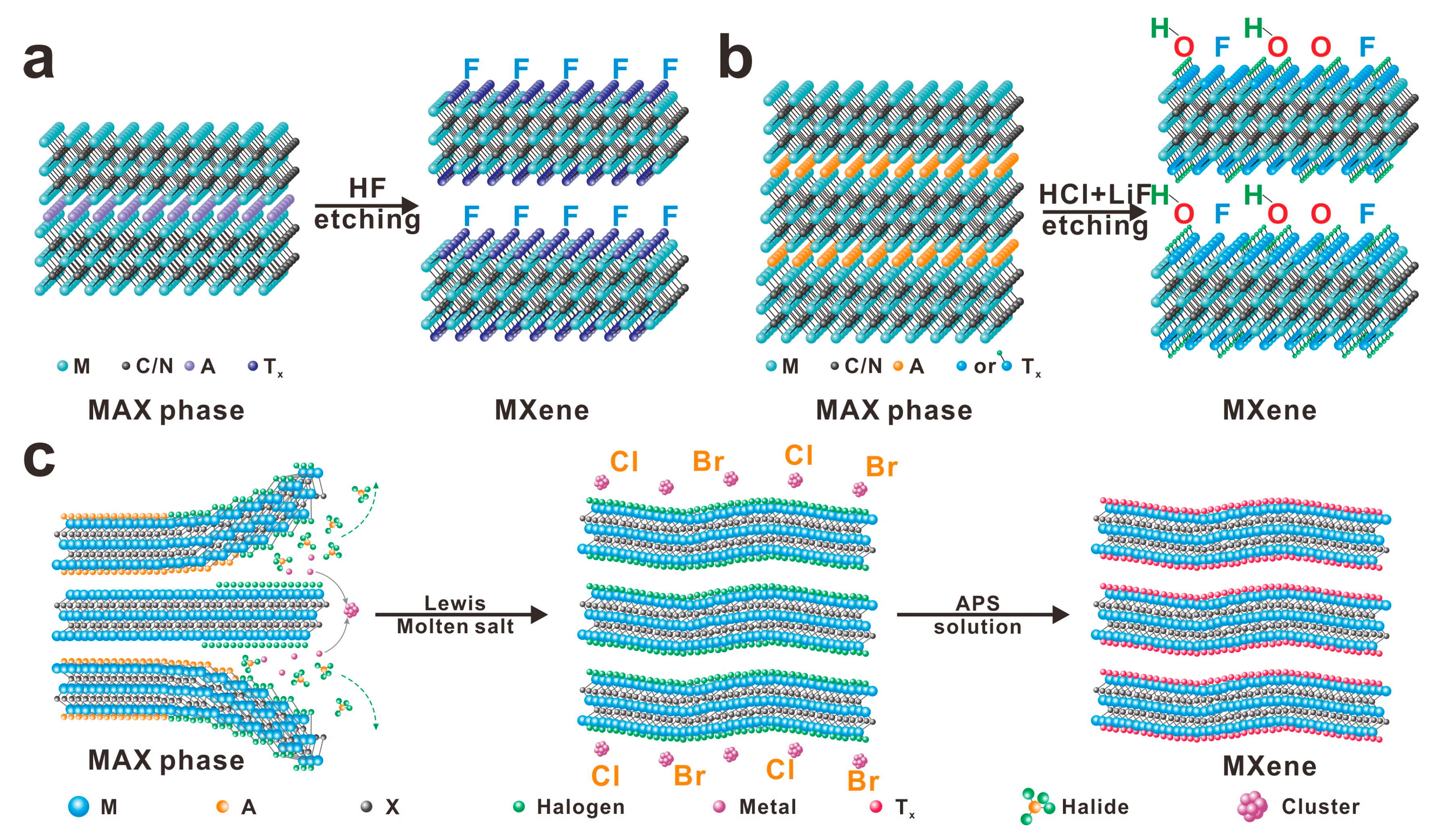
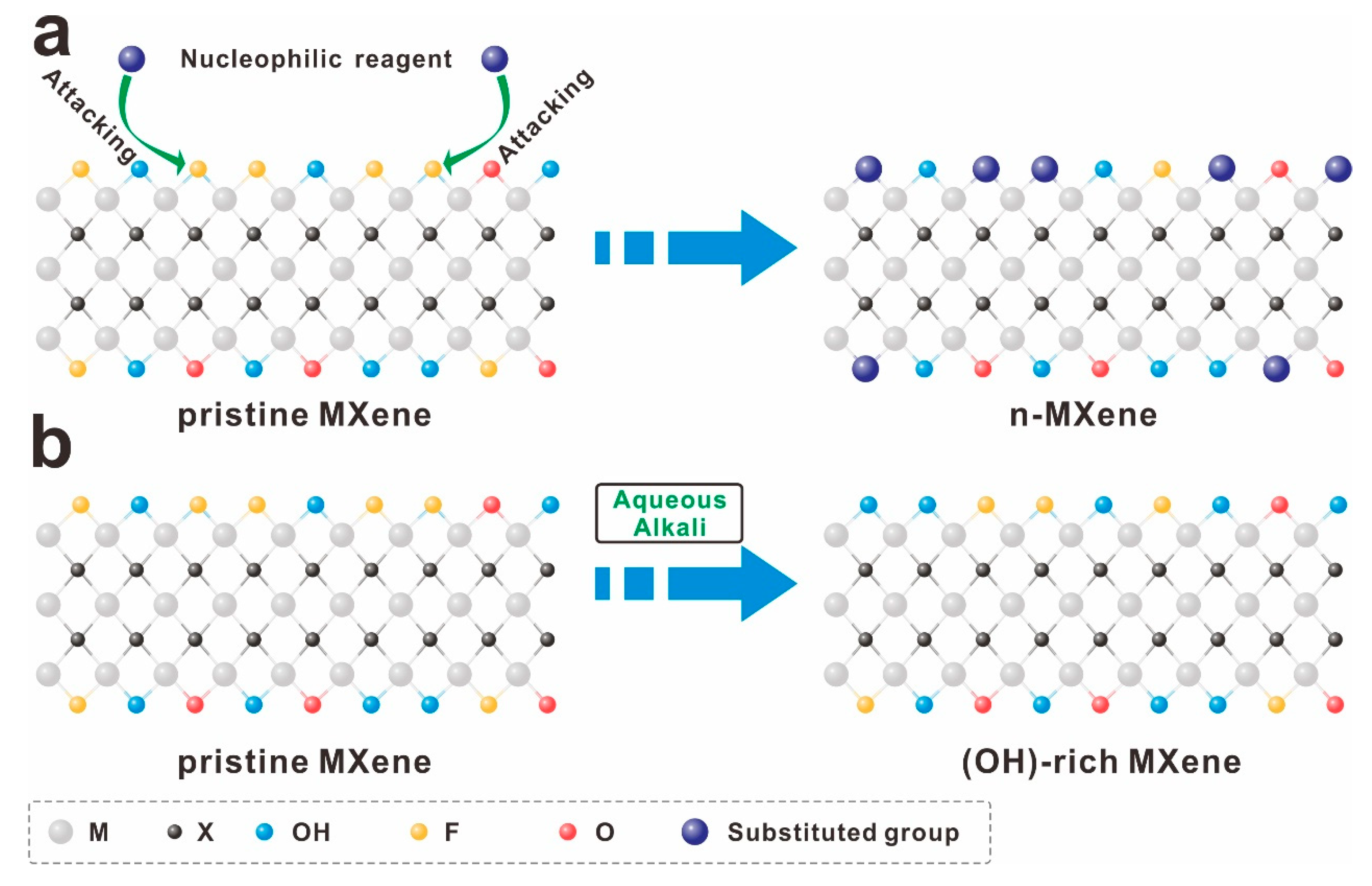
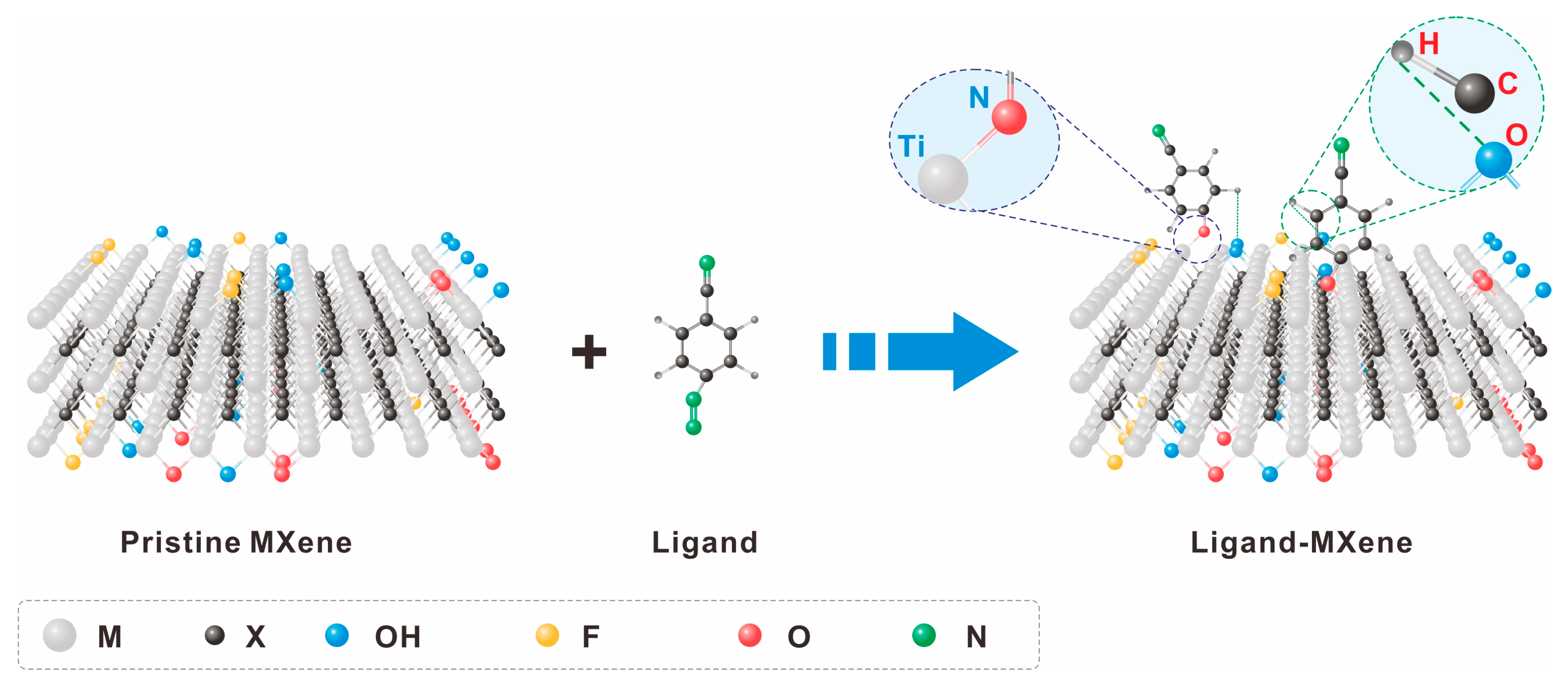

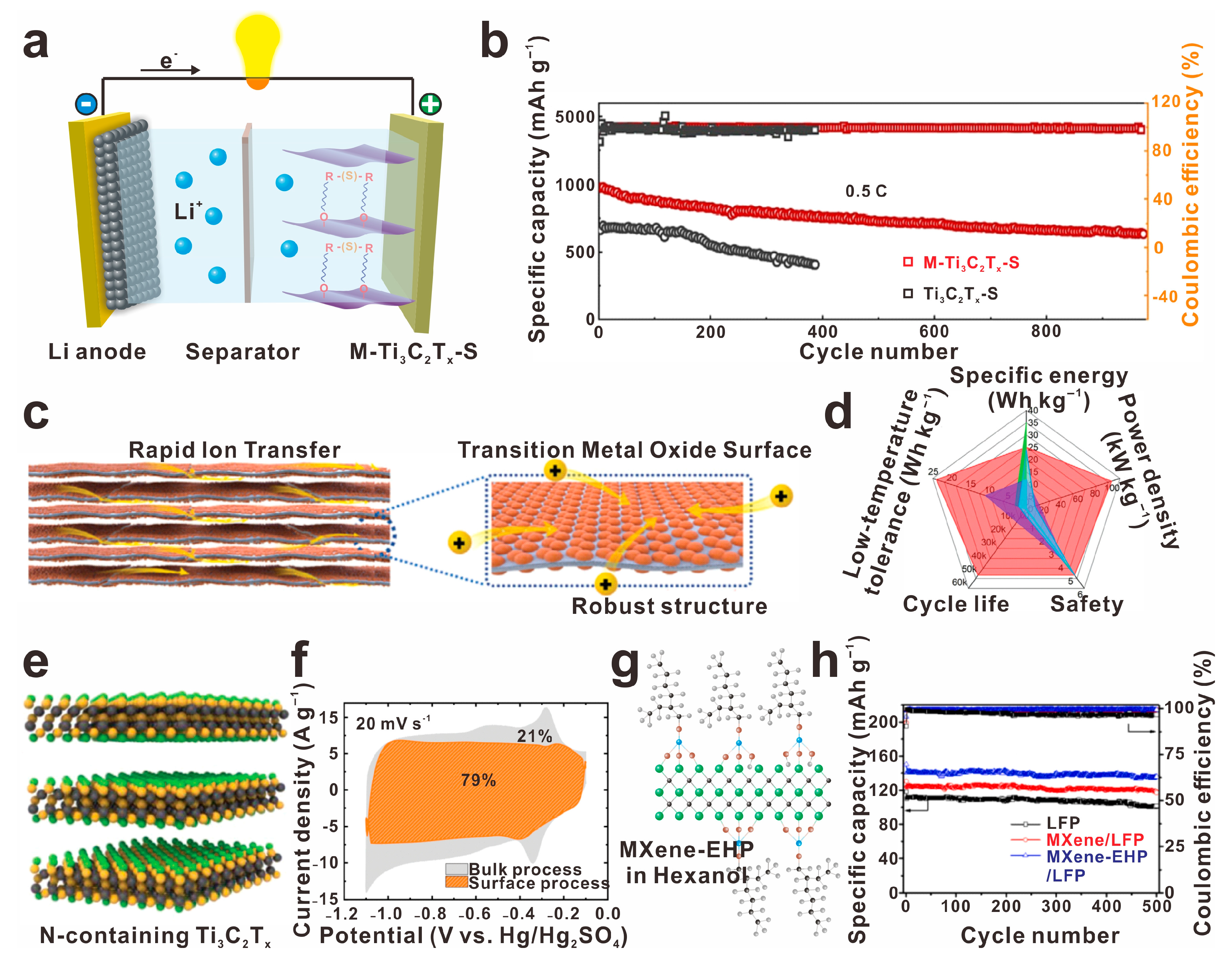
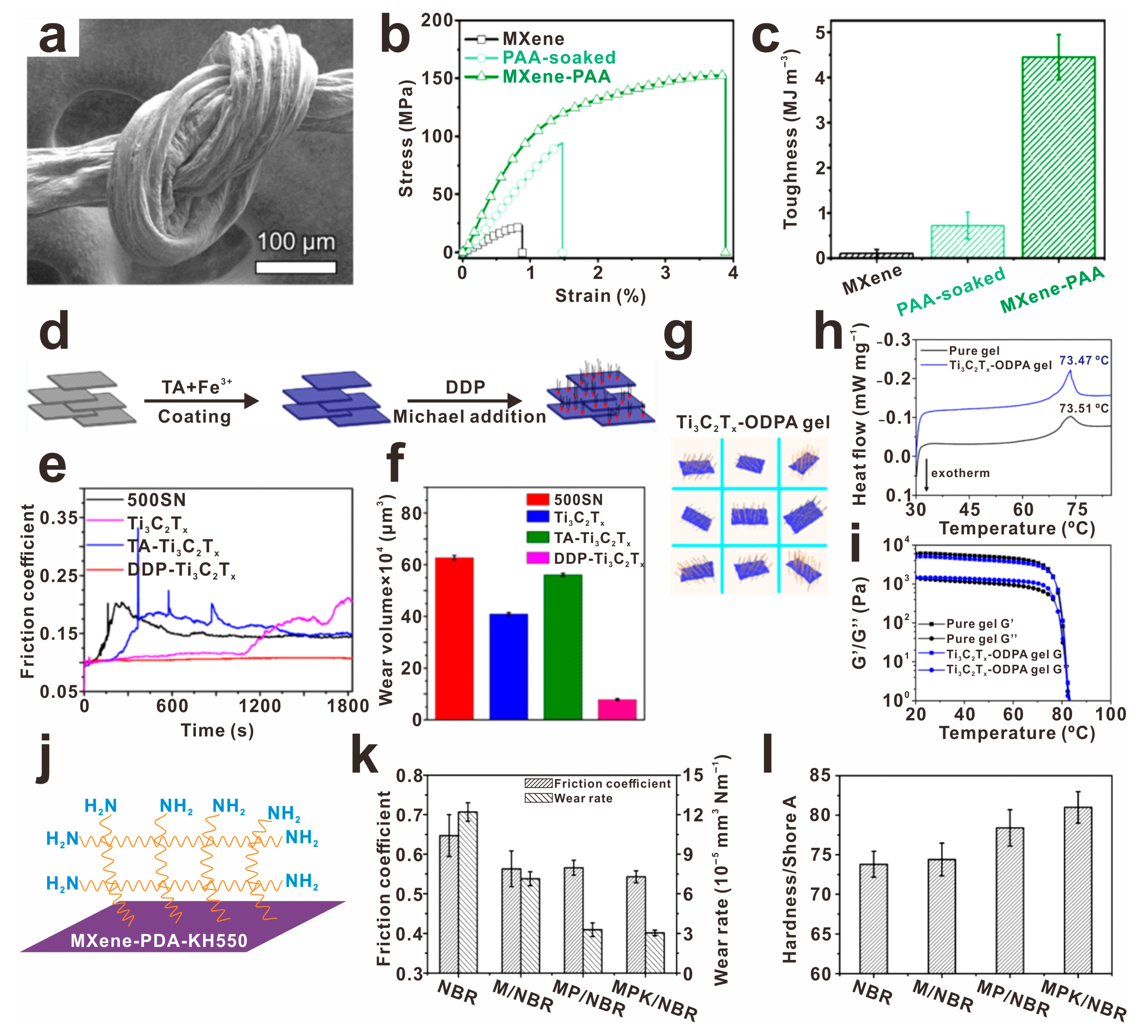
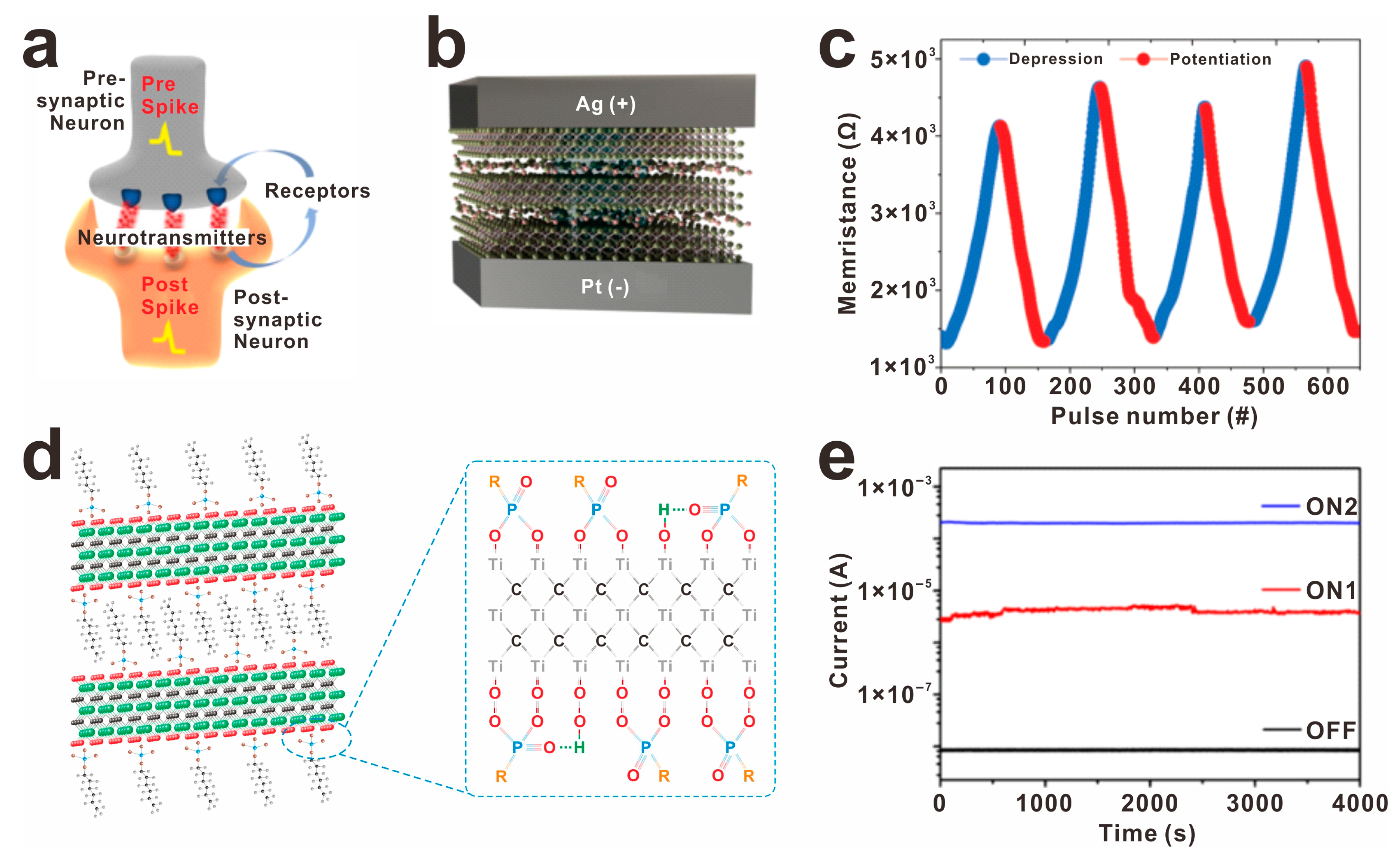

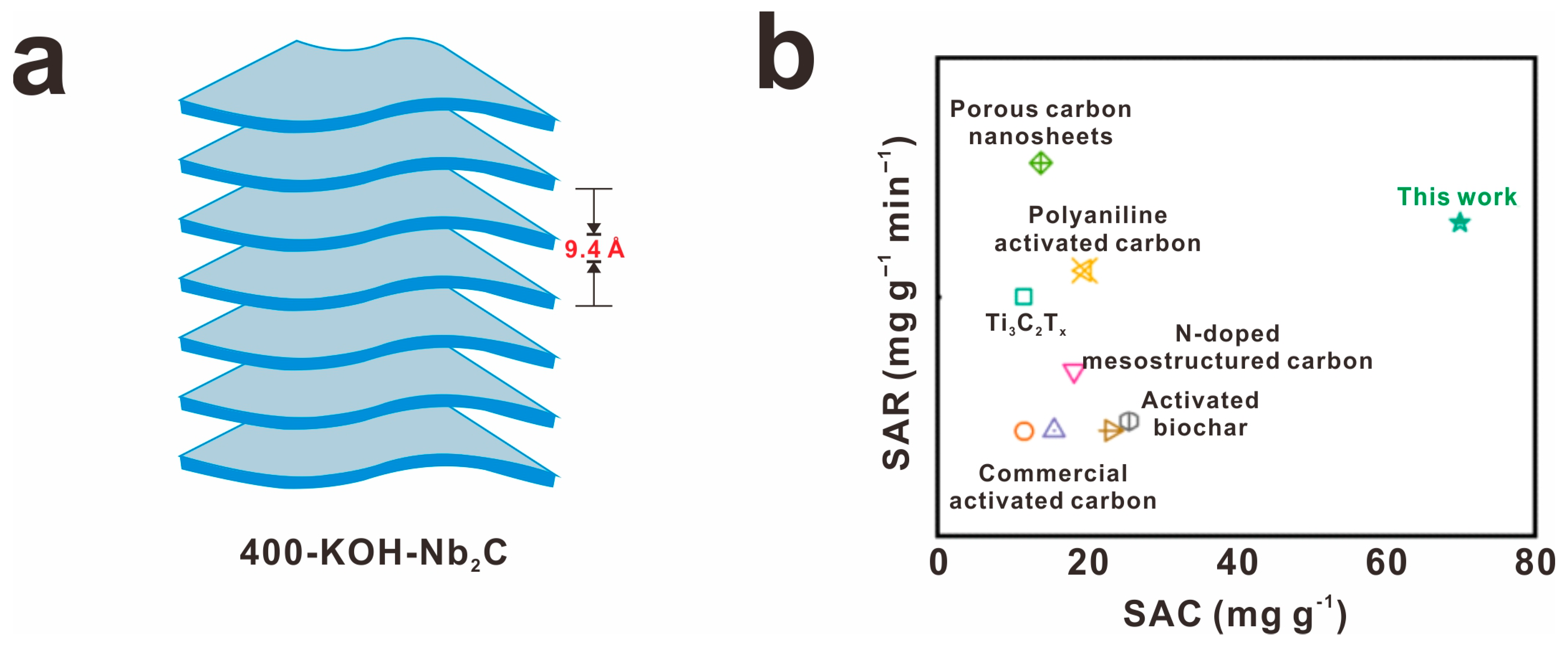
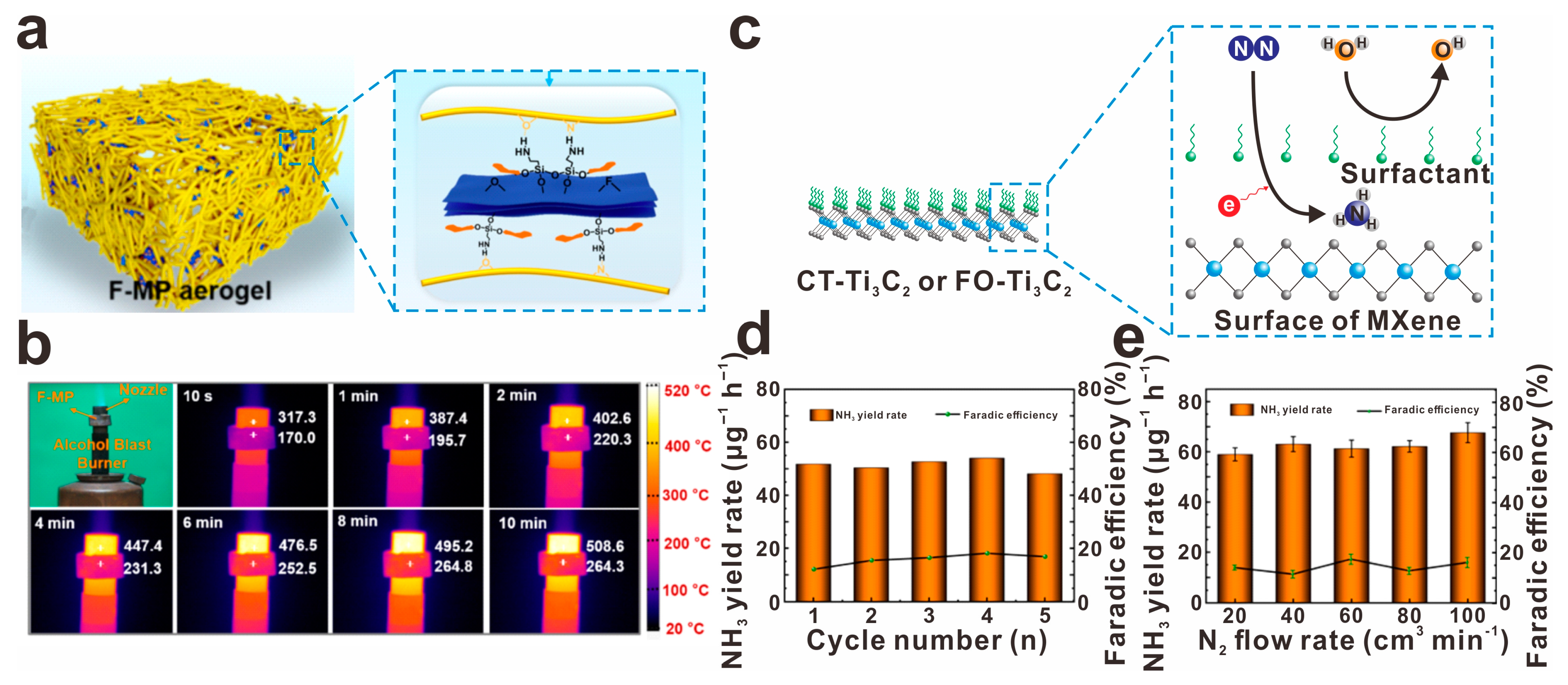
| Character | MXenes [26] | Graphene [27] | TMDs [28] | Black Phosphorous [29] |
|---|---|---|---|---|
| Surface component | Transition metal and carbon/nitrogen layer; the surface is rich in functional groups | Cellular sp2 carbon network, surface inert | Layered structure of transition metals with chalcogenide elements | The folded phosphorus layer, the surface of the lone pair electron enrichment |
| Functional group | (Adjustable) =O, -OH, -F, and -Cl | Need manual introduction: -COOH, -OH, -NH2 | Natural sulfur vacancies (S-vacancies) can support metal nanoparticles | Oxidation to form P-O/P=O group |
| Chemical stability | Easy oxidation in air (dependent on functional groups and metal composition) | High (inert surface corrosion resistance) | High (stable under non-extreme conditions) | Very low (inert atmosphere required) |
| Surface charge | Adjustable (pH-dependent Zeta potential) | Hydrophobic, negatively charged (after oxidation) | Negative charge | Amphoteric (pH responsiveness) |
| Functionalization strategy | Direct grafting (e.g., silane, polymer), ion intercalation | Covalent bonds (e.g., acylation), non-covalent bonds (π-π packing) | Sulfur vacancy modification, edge doping (Co, Ni, etc.) | Oxidative passivation, polymer encapsulation |
| Influence | Functional groups regulate electrical conductivity, hydrophilicity, and ionic diffusion rate | Functionalization reduces conductivity but increases dispersion | Sulfur vacancy improves catalytic activity and doping optimizes electronic structure | Oxidation results in a change in band gap and a decrease in carrier mobility |
| Applications | MXenes | Performance | Reference | |
|---|---|---|---|---|
| Before | After | |||
| Li-S battery | M-Ti3C2Tx | 815 mAh g−1 (capacitance) | 1034.5 mAh g−1 | [37] |
| Capacitor | Ti3C2Oy | 323 C g−1 (capacitance) | 1161 C g−1 | [70] |
| Capacitor | N-containing Ti3C2Tx | 83 mAh g−1 (capacitance) | 120 mAh g−1 | [71] |
| Supercapacitor | N-Ti3C2Tx | 628.3 C cm−3 (capacitance) | 936 C cm−3 | [72] |
| Supercapacitor | Ti3C2/PZS | 300 F g−1 (capacitance) | 380 F g−1 | [73] |
| Li ion battery | Ti3C2Tx/EHP/LFP | 118 mAh g−1 (capacitance) | 150 mAh g−1 | [74] |
| Mechanical materials | MXene-PAA | 30 MPa (tensile strength) | 155 MPa | [38] |
| Lubricant additives | DDP-Ti3C2Tx | 0.24 (coefficient of friction) | 0.11 | [75] |
| Lubricant additives | Ti3C2Tx-ODPA | 0.1 (coefficient of friction) | 0.046 | [76] |
| Nitrile butadiene rubber composites | Ti3C2-PDA | 0.647 (coefficients of friction) | 0.543 | [77] |
| Memristor | Ti3C2Ox | 104 (ON/OFF ratios) | 105 | [78] |
| Memristor | OP-Ti3C2Tx | 102.7 (ON/OFF ratios) | 104.1 | [79] |
| Biomedicine | MXene@Au-PEG-DOX | 1350 mm3 (tumor volume) | 75 mm3 | [80] |
| Biomedicine | CGDSTC NSs | -(photothermal conversion of efficiency) | 45.2% | [81] |
| Wastewater treatment | Alk-Ti3C2Tx | 11.98 mg g−1 (Ba2+ adsorption) | 46.46 mg g−1 | [82] |
| Capacitive deionization | 400-KOH-Nb2C | 33.5 mg g−1 (salt absorption capacity) | 104.2 mg g−1 | [83] |
| Aerogel | F-MP | ~500 °C (surface temperature) | ~264.3 °C | [84] |
| Reduction reaction of N2 | CT-TiC2 | 5.5% (Faradic efficiency) | 18.10% | [85] |
| Component of MXene | Conductivity | Hydrophilicity | Functional Group | Applications | Reference |
|---|---|---|---|---|---|
| Mo2CTx | 0.303–4.35 | 109.3 | =O, -OH | Electrocatalytic hydrogen evolution | [86,87] |
| Ti3C2Tx | ~500–20,000 | 90–106.99 | =O, -OH, -F | Supercapacitors, electromagnetic shielding | [88,89] |
| Nb2CTx | 0.0145–0.0923 | 30–36 | =O, -OH | Lithium sulfur battery, photothermal treatment | [90,91] |
| Ti2CTx | 1.63 × 10−8–0.3 | 45–65 | =O, -F | Transparent conducting thin film | [92,93] |
| V2CTx | 1560 | 33.6–101.9 | =O, -OH, -Cl | Magnetic sensor | [94,95] |
| Ti3CNTx | 0.128–909 | 0–25.1 | F, -OH, =O | Wear-resistant coating, composite material | [96,97] |
Disclaimer/Publisher’s Note: The statements, opinions and data contained in all publications are solely those of the individual author(s) and contributor(s) and not of MDPI and/or the editor(s). MDPI and/or the editor(s) disclaim responsibility for any injury to people or property resulting from any ideas, methods, instructions or products referred to in the content. |
© 2025 by the authors. Licensee MDPI, Basel, Switzerland. This article is an open access article distributed under the terms and conditions of the Creative Commons Attribution (CC BY) license (https://creativecommons.org/licenses/by/4.0/).
Share and Cite
Huang, W.; Wang, J.; Lai, W.; Guo, M. MXene Surface Architectonics: Bridging Molecular Design to Multifunctional Applications. Molecules 2025, 30, 1929. https://doi.org/10.3390/molecules30091929
Huang W, Wang J, Lai W, Guo M. MXene Surface Architectonics: Bridging Molecular Design to Multifunctional Applications. Molecules. 2025; 30(9):1929. https://doi.org/10.3390/molecules30091929
Chicago/Turabian StyleHuang, Wenxuan, Jiale Wang, Wei Lai, and Mengdi Guo. 2025. "MXene Surface Architectonics: Bridging Molecular Design to Multifunctional Applications" Molecules 30, no. 9: 1929. https://doi.org/10.3390/molecules30091929
APA StyleHuang, W., Wang, J., Lai, W., & Guo, M. (2025). MXene Surface Architectonics: Bridging Molecular Design to Multifunctional Applications. Molecules, 30(9), 1929. https://doi.org/10.3390/molecules30091929







